C++数据结构之AVL树如何实现
这篇文章主要讲解了“C++数据结构之AVL树如何实现”,文中的讲解内容简单清晰,易于学习与理解,下面请大家跟着小编的思路慢慢深入,一起来研究和学习“C++数据结构之AVL树如何实现”吧!
1.概念
(1)二叉搜索树的缺点
要手撕AVL树,我们首先要知道什么是AVL树。AVL树是在二叉搜索树的基础之上改造的。当我们插入的是一个有序的序列的时候,二叉搜素树会使用一条直线来进行存储,这样并不利于查找。

当遇到这种情况的时候我们就需要对这棵树来进行调整。AVL树会通过旋转等操作,来规避这种情况。最终满足每一个节点的平衡因子的绝对值<=1,从而达到近似平衡的目的。
节点的平衡因子值=右子树的高度-左子树高度
(2)定义节点
在AVL树中,除了需要定义平衡因子bf之外,还需要定义指向节点父节点的指针。方便我们来进行平衡因子的更新。
struct AVLTreeNode{AVLTreeNode* right;AVLTreeNode* left;AVLTreeNode* parent;pair<int, int> _kv;int _bf;AVLTreeNode(pair<int, int> kv):right(nullptr),left(nullptr),parent(nullptr),_kv(kv),_bf(0){}};同时和map一样,我们使用pair类型来进行数据的存储。
2.插入
(1)拆分
AVL树的插入就是AVL树的精髓所在,我们在插入节点的同时还需要对平衡因子进行控制。
AVL树的插入我们可以拆分成五个函数,其中四个为旋转函数,一个为主要的插入函数。
而这个主要的插入函数,我们还可以将其分为三个部分:找节点,插节点,更新平衡因子。而更新平衡因子后就需要判断是否需要进行旋转的操作。
在进行插入之前,我们将插入的节点定义为kv。
(2)找节点与插节点
这一过程与二叉搜索树是相同的,这里就不多赘述了。二叉搜索树
直接上代码:
//初始化头结点if (_root == nullptr){_root = new Node(kv);return true;}//找到要插入节点的位置Node* cur = _root;Node* parent = nullptr;while (cur){if (cur->_kv.first < kv.first){parent = cur;cur = cur->right;}else if (cur->_kv.first > kv.first){parent = cur;cur = cur->left;}else{assert(false);}}//插入节点cur = new Node(kv);if (parent->_kv.first<kv.first){parent->right = cur;cur->parent = parent;}else if (parent->_kv.first>kv.first){parent->left = cur;cur->parent = parent;}else{assert(false);}(3)更新平衡因子与旋转
更新平衡因子
每当我们插入一个节点的时候,就需要对该节点的所有父辈节点来进行平衡因子的更新。注意,当插入节点后,只有其父辈节点的平衡因子才会受到影响,而其他节点的平衡因子不会被影响。
可以根据每个节点的parent来找到其父亲节点,从而逐渐向上更新平衡因子。
当遇到以下两种情况平衡因子的更新停止。
某一父辈节点的平衡因子为0。
更新到根节点。
旋转
当更新之后的平衡因子为2或者-2的时候,不符合AVL树的平衡因子在-1~1之间的定义,此时需要发生旋转。触发旋转的条件与当前节点cur和它的parent有关。
当parent和cur的平衡因子分别为:
(1)2和1,触发左旋
void RotateL(Node* parent){Node* cur = parent->right;Node* curL = cur->left;Node* parentParent = parent->parent;parent->right = curL;if (curL)curL->parent = parent;cur->left = parent;parent->parent = cur;if (parent == _root){_root = cur;_root->parent = nullptr;}else{if (parentParent->left == parent){parentParent->left = cur;cur->parent = parentParent;}else if (parentParent->right == parent){parentParent->right = cur;cur->parent = parentParent;}else{assert(false);}}parent->_bf = 0;cur->_bf = 0;}用一张图来表示一下这个过程:
h表示某树的高度,当在红色部分处插入一个节点时,60的平衡因子变为1,30的平衡因子变为2。
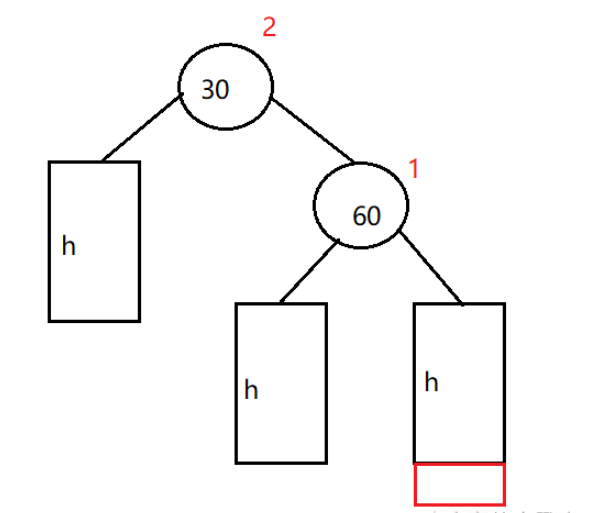
此时就需要发生旋转:

通过旋转使树重新变成一棵AVL树,整个过程分为三步:
60的左子树置为30,30的右子树置为60的左子树。
将30与更上层的父辈节点链接起来。
将30和60的平衡因子都更新为0。
注意,由于AVL树是三叉树,因此在链接的时候需要将父节点也链接起来。因此在将60的左子树链接到30的右子树的时候,需要进行判空来避免空指针的解引用:
void RotateL(Node* parent){Node* cur = parent->right;Node* curL = cur->left;Node* parentParent = parent->parent;parent->right = curL;if (curL)curL->parent = parent;cur->left = parent;parent->parent = cur;if (parent == _root){_root = cur;_root->parent = nullptr;}else{if (parentParent->left == parent){parentParent->left = cur;cur->parent = parentParent;}else if (parentParent->right == parent){parentParent->right = cur;cur->parent = parentParent;}else{assert(false);}}parent->_bf = 0;cur->_bf = 0;}(2)-2和-1,触发右旋
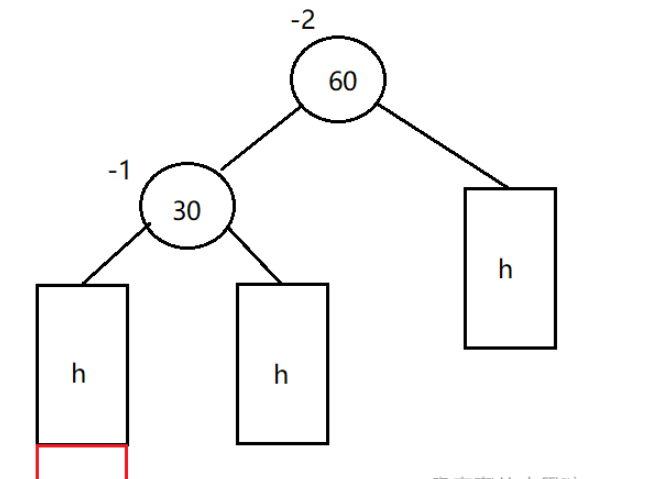

右旋同样分为三步:
将30的右链接到60的左子树。将60链接到30的右。
将30与上层节点链接起来。
将30和60的平衡因子都更新为0。
void RotateR(Node* parent){Node* cur = parent->left;Node* curL = cur->left;Node* curR = cur->right;Node* parentParent = parent->parent;parent->left = curR;if (curR)curR->parent = parent;cur->right = parent;parent->parent = cur;if (parent == _root){ _root = cur;_root->parent = nullptr;}else{if (parentParent->left == parent){parentParent->left = cur;cur->parent = parentParent;}else if (parentParent->right == parent){parentParent->right = cur;cur->parent = parentParent;}else{assert(false);}}cur->_bf = 0;parent->_bf = 0;}(3)-2和1,左右双旋
当为-2和1或者2和-1的时候,仅仅靠单旋是解决不了问题的,这个时候我们就需要进行双旋:
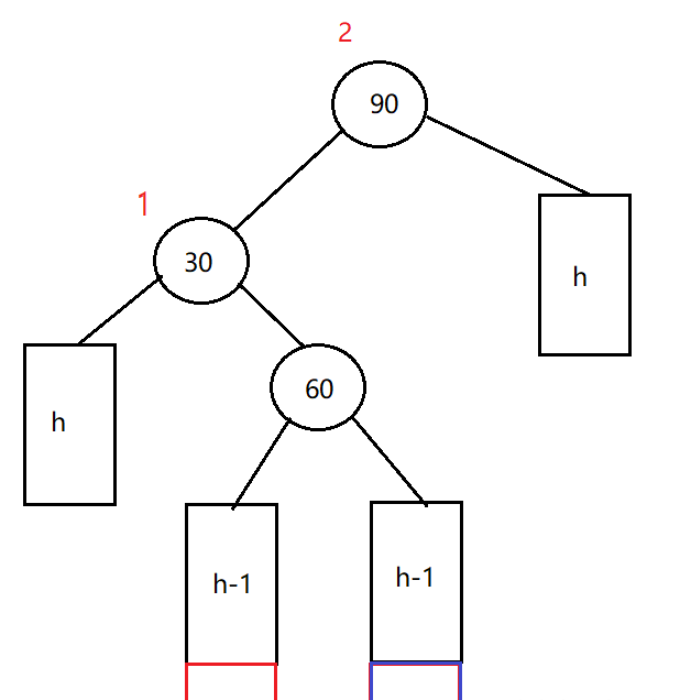
左单旋:
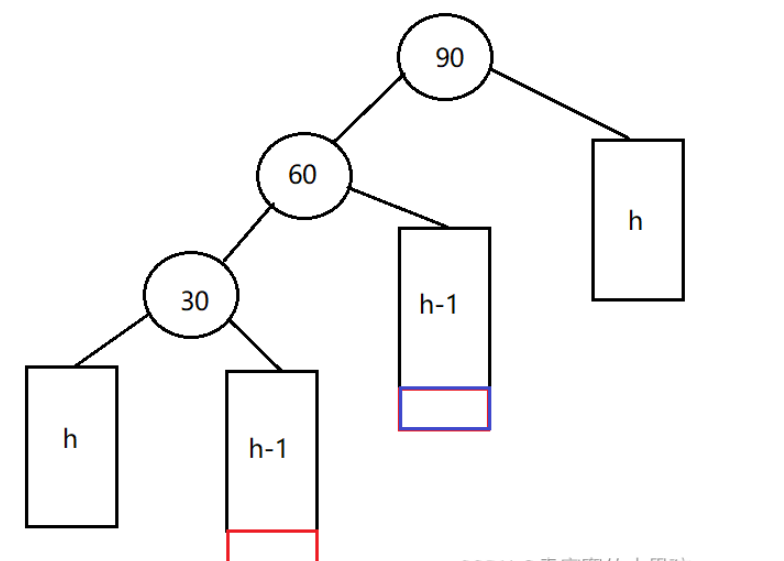
右单旋:
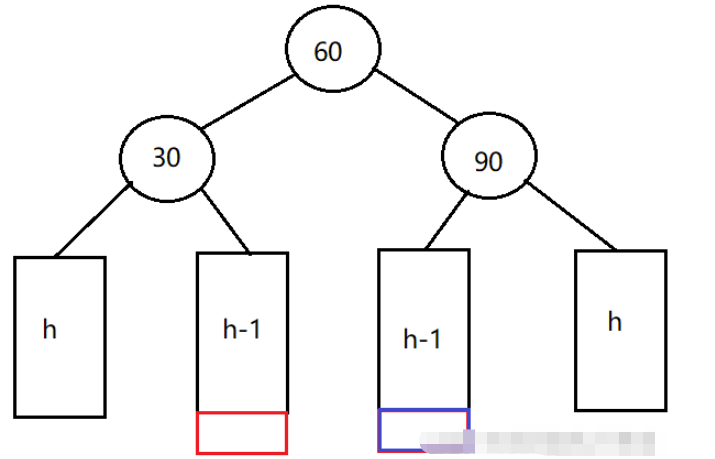
无论是在红色部分或者蓝色部分插入节点,都会导致发生左右双旋。
左右双旋分为三步:
对30节点进行左单旋。
对90节点进行右单旋。
根据60的平衡因子来更新30和90的平衡因子:当60的平衡因子为0时,30和90的平衡因子也为0;当60的平衡因子为1时,30的平衡因子为-1,90的平衡因子为0;当60的平衡因子为-1时,30的平衡因子为0,90的平衡因子为1。
void RotateLR(Node* parent){Node* subL = parent->left;Node* subLR =subL->right;int bf = subLR->_bf;RotateL(parent->left);RotateR(parent);if (bf == 0){parent->_bf = 0;subLR->_bf = 0;subLR->_bf = 0;}else if (bf == -1){parent->_bf = 1;subL->_bf = 0;subLR->_bf = 0;}else if (bf == 1){parent->_bf = 0;subL->_bf = -1;subLR->_bf = 0;}}(4)2和-1,右左双旋
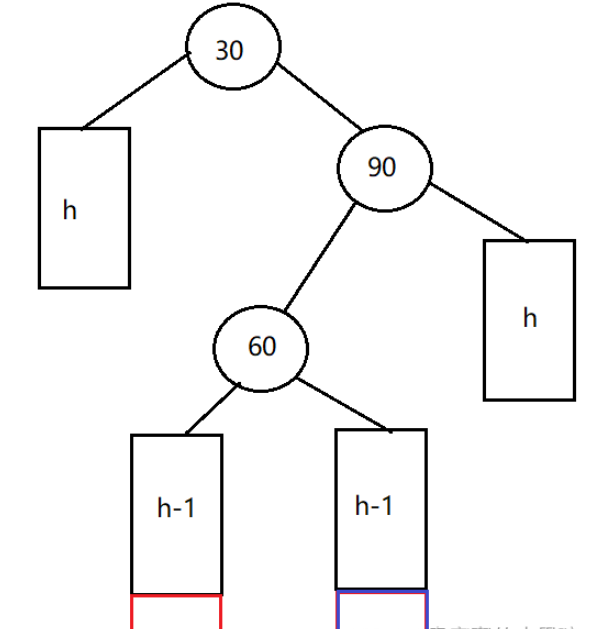
右单旋:
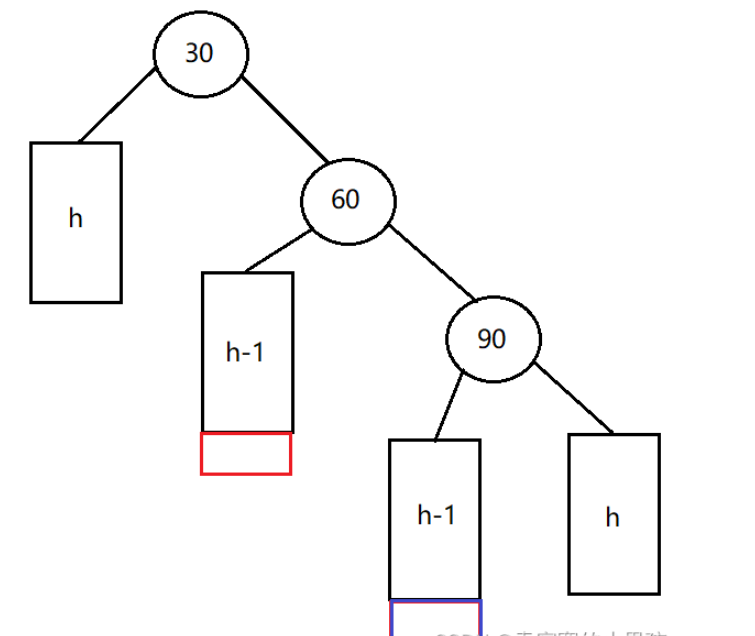
左单旋:
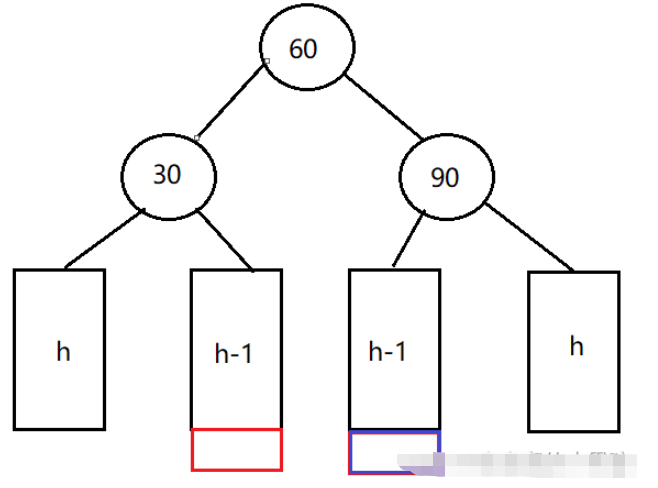
无论是在红色部分或者蓝色部分插入节点,都会导致发生右左双旋。
右左双旋分为三步:
对90节点进行右单旋。
对30节点进行左单旋。
根据60的平衡因子来更新30和90的平衡因子:当60的平衡因子为0时,30和90的平衡因子也为0;当60的平衡因子为1时,30的平衡因子为-1,90的平衡因子为0;当60的平衡因子为-1时,30的平衡因子为0,90的平衡因子为1。
void RotateRL(Node* parent){Node* subR = parent->right;Node* subRL = subR->left;int bf = subRL->_bf;RotateR(parent->right);RotateL(parent);if (bf == 0){parent->_bf = 0;subR->_bf = 0;subRL->_bf = 0;}else if (bf == 1){parent->_bf = -1;subR->_bf = 0;subRL->_bf = 0;}else if (bf == -1){parent->_bf = 0;subR->_bf = 1;subRL->_bf = 0;}else{assert(false);}}3.判断
我们可以建立一个函数来判断一棵树是否为AVL树。
我们使用递归来进行这一过程,依次判断各个子树是否为AVL树。
要判断我们就需要知道每一棵树的高度,此时我们需要构造一个求树的高度的函数Height。它也由递归来实现。
int Height(Node* root){if (root == nullptr){return 0;}int leftHeight = Height(root->left);int rightHeight = Height(root->right);return rightHeight > leftHeight ? rightHeight + 1 : leftHeight + 1;}bool IsBalance(){return _IsBalance(_root);}bool _IsBalance(Node* root){if (root == nullptr){return true;}int leftHeight = Height(root->left);int rightHeight = Height(root->right);if ((rightHeight - leftHeight) != root->_bf){cout << "现在是:" << root->_bf << endl;cout << "应该是:" << rightHeight - leftHeight << endl;return false;}return abs(rightHeight - leftHeight) < 2 && _IsBalance(root->left) && _IsBalance(root->right);}4.完整代码及测试代码
完整代码
#pragma once#include<iostream>#include<assert.h>#include<math.h>using namespace std;struct AVLTreeNode{AVLTreeNode* right;AVLTreeNode* left;AVLTreeNode* parent;pair<int, int> _kv;int _bf;AVLTreeNode(pair<int, int> kv):right(nullptr),left(nullptr),parent(nullptr),_kv(kv),_bf(0){}};class AVLTree{typedef AVLTreeNode Node;public:AVLTree(){_root = nullptr;}void InOrder(){_InOrder(_root);}void _InOrder(Node* root){if (root == nullptr){return;}_InOrder(root->left);cout << root->_kv.first << ":" << root->_kv.second << endl;_InOrder(root->right);}int Height(Node* root){if (root == nullptr){return 0;}int leftHeight = Height(root->left);int rightHeight = Height(root->right);return rightHeight > leftHeight ? rightHeight + 1 : leftHeight + 1;}bool IsBalance(){return _IsBalance(_root);}bool _IsBalance(Node* root){if (root == nullptr){return true;}int leftHeight = Height(root->left);int rightHeight = Height(root->right);if ((rightHeight - leftHeight) != root->_bf){cout << "现在是:" << root->_bf << endl;cout << "应该是:" << rightHeight - leftHeight << endl;return false;}return abs(rightHeight - leftHeight) < 2 && _IsBalance(root->left) && _IsBalance(root->right);}//右单旋void RotateR(Node* parent){Node* cur = parent->left;Node* curL = cur->left;Node* curR = cur->right;Node* parentParent = parent->parent;parent->left = curR;if (curR)curR->parent = parent;cur->right = parent;parent->parent = cur;if (parent == _root){ _root = cur;_root->parent = nullptr;}else{if (parentParent->left == parent){parentParent->left = cur;cur->parent = parentParent;}else if (parentParent->right == parent){parentParent->right = cur;cur->parent = parentParent;}else{assert(false);}}cur->_bf = 0;parent->_bf = 0;}//左单旋void RotateL(Node* parent){Node* cur = parent->right;Node* curL = cur->left;Node* parentParent = parent->parent;parent->right = curL;if (curL)curL->parent = parent;cur->left = parent;parent->parent = cur;if (parent == _root){_root = cur;_root->parent = nullptr;}else{if (parentParent->left == parent){parentParent->left = cur;cur->parent = parentParent;}else if (parentParent->right == parent){parentParent->right = cur;cur->parent = parentParent;}else{assert(false);}}parent->_bf = 0;cur->_bf = 0;}//左右双旋void RotateLR(Node* parent){Node* subL = parent->left;Node* subLR =subL->right;int bf = subLR->_bf;RotateL(parent->left);RotateR(parent);if (bf == 0){parent->_bf = 0;subLR->_bf = 0;subLR->_bf = 0;}else if (bf == -1){parent->_bf = 1;subL->_bf = 0;subLR->_bf = 0;}else if (bf == 1){parent->_bf = 0;subL->_bf = -1;subLR->_bf = 0;}}//右左双旋void RotateRL(Node* parent){Node* subR = parent->right;Node* subRL = subR->left;int bf = subRL->_bf;RotateR(parent->right);RotateL(parent);if (bf == 0){parent->_bf = 0;subR->_bf = 0;subRL->_bf = 0;}else if (bf == 1){parent->_bf = -1;subR->_bf = 0;subRL->_bf = 0;}else if (bf == -1){parent->_bf = 0;subR->_bf = 1;subRL->_bf = 0;}else{assert(false);}}bool InsertNode(pair<int, int> kv){//初始化头结点if (_root == nullptr){_root = new Node(kv);return true;}//找到要插入节点的位置Node* cur = _root;Node* parent = nullptr;while (cur){if (cur->_kv.first < kv.first){parent = cur;cur = cur->right;}else if (cur->_kv.first > kv.first){parent = cur;cur = cur->left;}else{assert(false);}}//插入节点cur = new Node(kv);if (parent->_kv.first<kv.first){parent->right = cur;cur->parent = parent;}else if (parent->_kv.first>kv.first){parent->left = cur;cur->parent = parent;}else{assert(false);}//更新插入节点以上的平衡因子while (parent){if (cur == parent->left){parent->_bf--;}else if (cur == parent->right){parent->_bf++;}if (parent->_bf == 0){break;}else if (parent->_bf == 1 || parent->_bf == -1){cur = parent;parent = parent->parent;}else if (parent->_bf == 2 || parent->_bf == -2){if (parent->_bf == -2 && cur->_bf == -1){RotateR(parent);//右单旋}else if (parent->_bf == 2 && cur->_bf == 1){RotateL(parent);//左单旋}else if (parent->_bf == -2 && cur->_bf == 1){RotateLR(parent);}else if (parent->_bf == 2 && cur->_bf == -1){RotateRL(parent);}}else{assert(false);}}}private:Node* _root;};测试代码
#define _CRT_SECURE_NO_WARNINGS 1 #include"AVLTree.h"void TestRotateR(){AVLTree t;t.InsertNode(make_pair(5, 1));t.InsertNode(make_pair(4, 1));t.InsertNode(make_pair(3, 1));t.InsertNode(make_pair(2, 1));t.InsertNode(make_pair(1, 1));t.InsertNode(make_pair(0, 1));t.InOrder();cout << t.IsBalance() << endl;}void TestRotateL(){AVLTree t;t.InsertNode(make_pair(0, 1));t.InsertNode(make_pair(1, 1));t.InsertNode(make_pair(2, 1));t.InsertNode(make_pair(3, 1));t.InsertNode(make_pair(4, 1));t.InsertNode(make_pair(5, 1));t.InOrder();cout << t.IsBalance() << endl;}void Testbf(){AVLTree t;t.InsertNode(make_pair(5, 1));t.InsertNode(make_pair(7, 1));t.InsertNode(make_pair(3, 1));t.InsertNode(make_pair(4, 1));t.InsertNode(make_pair(2, 1));t.InsertNode(make_pair(8, 1));t.InsertNode(make_pair(9, 1));t.InsertNode(make_pair(6, 1));t.InsertNode(make_pair(1, 1));t.InsertNode(make_pair(11, 1));t.InOrder();cout << t.IsBalance() << endl;}void TestRL(){AVLTree t;t.InsertNode(make_pair(60, 1));t.InsertNode(make_pair(50, 1));t.InsertNode(make_pair(90, 1));t.InsertNode(make_pair(100, 1));t.InsertNode(make_pair(80, 1));t.InsertNode(make_pair(70, 1));t.InOrder();cout << t.IsBalance() << endl;}void TestLR(){AVLTree t;t.InsertNode(make_pair(90, 1));t.InsertNode(make_pair(100, 1));t.InsertNode(make_pair(60, 1));t.InsertNode(make_pair(50, 1));t.InsertNode(make_pair(70, 1));t.InsertNode(make_pair(80, 1));t.InOrder();cout << t.IsBalance() << endl;}int main(){//TestRotateR();//Testbf();//TestRotateL();//TestRL();TestLR();}感谢各位的阅读,以上就是“C++数据结构之AVL树如何实现”的内容了,经过本文的学习后,相信大家对C++数据结构之AVL树如何实现这一问题有了更深刻的体会,具体使用情况还需要大家实践验证。这里是编程网,小编将为大家推送更多相关知识点的文章,欢迎关注!
免责声明:
① 本站未注明“稿件来源”的信息均来自网络整理。其文字、图片和音视频稿件的所属权归原作者所有。本站收集整理出于非商业性的教育和科研之目的,并不意味着本站赞同其观点或证实其内容的真实性。仅作为临时的测试数据,供内部测试之用。本站并未授权任何人以任何方式主动获取本站任何信息。
② 本站未注明“稿件来源”的临时测试数据将在测试完成后最终做删除处理。有问题或投稿请发送至: 邮箱/279061341@qq.com QQ/279061341
















